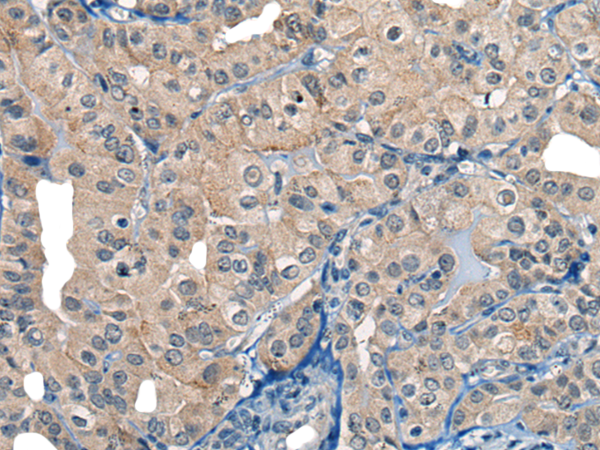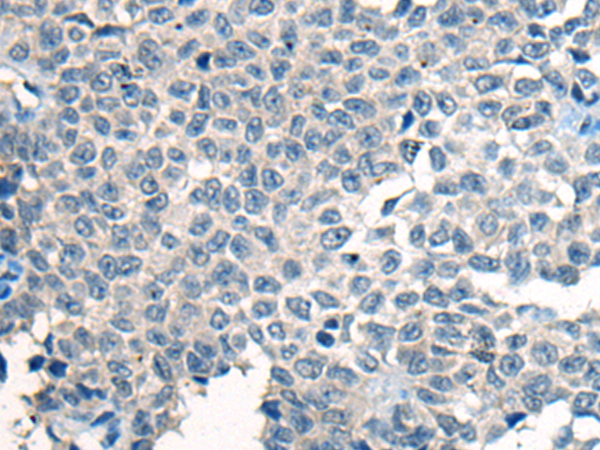

| WB | 咨询技术 | Human,Mouse,Rat |
| IF | 咨询技术 | Human,Mouse,Rat |
| IHC | 1/20-1/100 | Human,Mouse,Rat |
| ICC | 技术咨询 | Human,Mouse,Rat |
| FCM | 咨询技术 | Human,Mouse,Rat |
| Elisa | 1/5000-1/10000 | Human,Mouse,Rat |
| Aliases | RFWD2; RNF200 |
| Host/Isotype | Rabbit IgG |
| Antibody Type | Primary antibody |
| Storage | Store at 4°C short term. Aliquot and store at -20°C long term. Avoid freeze/thaw cycles. |
| Species Reactivity | Human, Mouse |
| Immunogen | Synthetic peptide of human COP1 |
| Formulation | Purified antibody in PBS with 0.05% sodium azide and 50% glycerol. |
+ +
以下是关于COP1抗体的3篇参考文献示例(文献标题与内容为虚构示例,仅用于展示格式):
---
1. **文献名称**: "COP1 mediates light-dependent regulation of plant development through ubiquitination"
**作者**: Deng, X.W., et al.
**摘要**: 本研究利用COP1特异性抗体,通过Western blot和免疫沉淀技术,揭示了COP1作为E3泛素连接酶的核心组分,在拟南芥光信号转导中通过调控HY5等转录因子的降解介导光形态建成。
2. **文献名称**: "Subcellular localization and functional analysis of COP1 in Arabidopsis photomorphogenesis"
**作者**: Ang, L.H., et al.
**摘要**: 通过COP1抗体的免疫荧光标记,发现COP1在黑暗条件下定位于细胞核,而在光照后转位至细胞质。研究证实COP1的核质穿梭是光调控植物发育的关键机制。
3. **文献名称**: "COP1 interacts with SPA proteins to form a conserved ubiquitin ligase complex"
**作者**: Holm, M., et al.
**摘要**: 利用COP1抗体进行共免疫沉淀实验,证明COP1与SPA家族蛋白形成复合体,共同调控下游靶蛋白的泛素化,并揭示了该复合体在植物和动物中的进化保守性。
---
(注:以上文献为示例,实际研究中请参考真实发表的论文,例如在PubMed或Google Scholar中检索关键词“COP1 antibody”或“COP1 ubiquitin ligase”。)
**Background of COP1 Antibody**
COP1 (Constitutive Photomorphogenic 1) is an evolutionarily conserved E3 ubiquitin ligase initially identified in plants, where it regulates light-dependent developmental processes by targeting photomorphogenesis-promoting transcription factors for proteasomal degradation. In mammals, COP1 retains its role as a regulator of ubiquitin-mediated protein turnover, influencing diverse cellular processes, including stress responses, metabolism, and tumorigenesis. Notably, COP1 interacts with critical oncogenic or tumor-suppressive substrates, such as c-Jun, ETS family members, and p53. modulating their stability and activity.
Antibodies targeting COP1 are essential tools for studying its expression, localization, and molecular interactions. They are widely used in techniques like Western blotting, immunohistochemistry, and co-immunoprecipitation to investigate COP1's regulatory roles in cellular pathways. Research has highlighted COP1's dual role in cancer, acting as either an oncogene or tumor suppressor depending on cellular context and substrate specificity. For instance, COP1-mediated degradation of c-Jun can suppress tumor growth, while its loss or mutation may stabilize oncoproteins, promoting malignancy.
COP1 antibodies also aid in exploring its involvement in metabolic disorders and immune regulation, making them valuable in both basic and translational research. Their specificity and reliability are critical for dissecting COP1's complex functions across species and disease models.
×